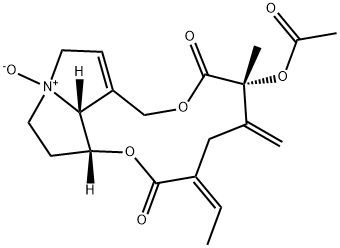Acetylseneciphylline N-oxide—A Pyrrolizidine alkaloid
Chemical Structure and related Plant Genera
Deriving from seneciphylline, acetylseneciphylline N-oxide has a role as a Jacobaea metabolite. Structurally, it is an acetate ester, a macrocyclic lactone, an olefinic compound, an organic heterotricyclic compound, a pyrrolizine alkaloid and a tertiary amine oxide. Acetylseneciphylline N-oxide is a pyrrolizine alkaloid that is seneciphylline in which the hydroxy hydrogen has been replaced by an acetyl group and the tertiary amino function has been oxidized to the corresponding N-oxide.

Pyrrolizidine alkaloids (PAs) are plant secondary metabolites characteristic of several genera within the Asteraceae and Boraginaceae, and sporadically present in the Fabaceae and Orchidaceae. PAs are formed by the esterification of a necic acid and a necine base, and comprise more than 400 chemical structures identified from ca. 6000 species. In Senecio (Asteraceae), one of the largest genera of flowering plants distributed worldwide, PAs are mostly in a macrocyclic diester form.
Mammalian Toxicity of Pyrrolizidine alkaloids (PAs)
PAs are acutely toxic, genotoxic and teratogenic to vertebrates and invertebrates. Chronic ingestion of PA-containing plants and contaminated hay, straw or silage, causes livestock poisoning. In humans, exposure to PAs contained in herbal teas, medicines, contaminated cereals, pollen and honey has been related to acute and chronic liver toxicity, such as the veno-occlusive disease, especially in children. The role of PAs as plant chemical defenses against phytophagous insects has been widely documented. Indeed, PAs may have evolved in response to the consumption pressure from invertebrate herbivores. PAs are largely stored in the plant foliage in the non-toxic N-oxide form. However, after ingested by herbivores they are reduced into tertiary amines in the gut and metabolized by cytochrome P450s, originating reactive metabolites that interact with proteins and nucleic acids. The toxicity of PAs strongly depends on some molecular features. For example, the presence of a double bond at C1–C2 in the necine base, as occurring in retronecine and otonecine bases (often referred to as 1,2-unsaturated Pas or dehydroPAs), is necessary for their bioactivation and it has been associated to a greater toxicity in comparison with saturated necine bases. Accordingly, the toxic potential of PA-containing plants will depend on the PA absolute concentrations but also on the PA profile, that is the relative abundance of individual PAs.
PAs are hepatotoxic, carcinogenic, genotoxic and teratogenic after a bioactivation by cytochromes P450 which occurs under the presence of a double bond at C1–C2. Spatial differences in individual PA concentrations were found for most retronecine and otonecines and all platynecine and rosmarinecines, but not for saturated otonecines. Rosmarinine N-oxide was the most abundant PA in Australia, Western South Africa and Eastern South Africa. In Europe, however, it was comparatively scarce, and the predominant compounds were acetylseneciphylline N-oxide, seneciphylline N-oxide and senecionine N-oxide.
References
[1]. Cheng D, et al. The relationship between structurally different pyrrolizidine alkaloids and western flower thrips resistance in F (2) hybrids of Jacobaea vulgaris and Jacobaea aquatica. J Chem Ecol., 2011, 37(10): 1071-1080.
[2]. Joosten, L.; Cheng, D.; Mulder, P. P. J.; et al. The genotype dependent presence of pyrrolizidine alkaloids as tertiary amine in Jacobaea vulgaris. Phytochemistry, 2011, 70: 214–222.
);

